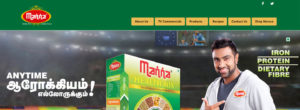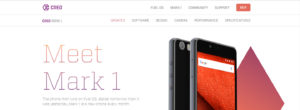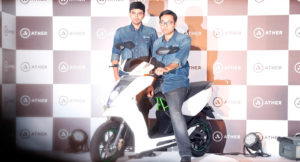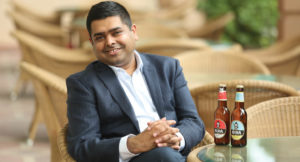Amit Ladsaria, Director of Turtle Limited, the men’s ready-made apparel company, aims to maintain a 25 per cent revenue growth rate, expand in clusters into various cities and completely transform Turtle into an affordable fashion brand

“The brand Turtle means everything to me,” says Amit Ladsaria as we start the interview. In 1993, when he was still in college, he, along with his uncle Sanjay Jhunjhunwala, started Turtle Limited with a primary focus on men’s readymade shirts. From being very hands on during the initial days of the company, he has nurtured this brand with a lot of passion and has seen it grow at a steady pace for the last 23 years. Recollecting the early days, Ladsaria says, “We were young and the market had not opened up much during the first ten years. However, in the last ten years, after modern retail came in, there has been a lot of visibility for our brand.”
Based out of Kolkata, Turtle Limited started its journey with a manufacturing capacity of 20 shirts per day for supplies to an in-house retail store. It has come a long way since then. Today it provides a complete range of clothing and accessories for men and currently has the capacity to make 2.5 million pieces a year. Turtle Limited’s presence is felt in 400 cities across India with over 96 exclusive stores for its two brands, Turtle and London Bridge. It has a team size of around 1,000 spread across India. Its merchandise is available in over 1,200 multi-brand outlets and in over 175 large format retail stores (including Shoppers Stop, Pantaloons, Brand Factory, Reliance Trends and Central). With revenues of above Rs.160 crore, Turtle is targeting a CAGR of around 25 per cent in the next few years.
Sector dynamics
As we all know, after modern retail set in, there have been a lot of changes in this industry and to a large extent, it has helped in streamlining the sector. “Consumers expect their brands to open their own stores and showcase their own range,” observes Ladsaria. This apart, it is now an end-to-end cycle where the relationship between the buyer and seller doesn’t end after the product is despatched. “It actually starts after we despatch the content,” states he.
Through Turtle and London Bridge, the company has remained focussed on men’s apparel. It feels that the ladies and children’s apparel is a different game altogether in terms of design and consumers and it didn’t want to divert its attention. “We feel there is a lot of scope in the men’s space and we can do much more here than what we are doing currently,” says he. A clear focus on quality, supply chain and mid-level pricing has helped the company in the long run. “We have always been a value for money brand,” says Ladsaria. However, he is quick to add, “That does not mean that we sell cheap. Our price starts from Rs. 1,000 a shirt and goes up to Rs. 2,500 shirt. But, whatever products we offer, the perception of the product is higher.” He believes that the way they have priced their shirts have helped consumers associate themselves with the brand. The company has invested wisely in supply chain tools. It also has partnerships with logistics companies which will help it deliver the material on time to the store.
Turtle’s designs are available in two seasons – spring summer and autumn winter. “Every week during this period, new designs get added to this collection,” says the co-founder.
Talking about the name Turtle, Ladsaria recollects, “We were watching the movie Ninja Turtle and that’s when we thought of christening our brand with the name Turtle. We wanted to associate positive qualities of the reptile, like long life, adaptability and tough exterior soft interior, with the brand.” However, for the company, it didn’t stop with just the name. It has also been actively engaged in the conservation and protection of turtles in India for years. It recently entered into a partnership with TSA (Turtle Survival Alliance) – an international organization working towards conservation of endangered species of turtles in multiple countries across the globe.
Working closely with the ecosystem
This year, the company has adopted a cluster approach for expanding its stores in various cities. “We have two to three clusters and expand in that cluster so that we are able to optimise our advertising spends in those areas,” says Ladsaria. Currently, its focus is on the East cluster – West Bengal, Bihar, Assam and Orissa. Its other focus area is Karnataka. “These are the five states we are operationally strong in and we are opening stores in these states this year,” says he. While its main focus is the cluster approach, it does have stores in other cities as well like Lucknow in UP. “If we open 20 stores, 15 will be in clusters and five in other cities,” says Ladsaria.
Commenting about competition, he says, “The way we deal with competition is to associate ourselves with our customer and maintain a level of quality that they want.” As far as online players go, they have huge discounts and we all know that they are burning money. “They want to acquire the customer immediately. However, a lot of sanity has come in and there are lesser discounts. It’s just a phase and nothing more,” believes he.
The company spends almost five to six per cent of its revenues on advertising. This apart, today, what makes a product attractive is the design that one has to offer. “If the customer likes your design he will keep coming back to you,” says Ladsaria. Companies also have to be omnipresent –online, offline, MBOs and so on. “If you get your reaching out act right, you will be fine with respect to competition,” opines he.
Turtle is also among the few brands from India which have a foothold in overseas markets such as Dubai, Bahrain, Muscat, Jeddah, Saudi Arabia, and Kuwait. “Other brands export to Europe and U.S., however, there are no Indians abroad (category) in these markets,” says Ladsaria.
Building the brand Turtle
The company formulates its brand building strategy a year in advance. It has a multipronged approach with a fair mix of out-of-home, radio, newspapers and digital marketing. Positioned as a mass premium brand, Turtle finds that its biggest challenge lies in understanding the needs of its consumer. And, the team has tried to overcome this challenge through a mix of research, feedback and of course, gut feel. “In the last 25 years, I have never seen such a radical change in the men’s fashion world. Earlier shirt was more of a commodity, now a consumer doesn’t want to use a shirt for more than three to four times. There are significant changes happening in prints, sizes and so on. Hence, we never stop innovating,” states Ladsaria. The current trend is feminine colours, printed garments and smart casuals and the company’s target audience is in the age group of 28 years to 35 years. “Of course, it goes without saying that others use it too,” adds he.
Setting a steady pace
Turtle aims to completely transform itself into a fashion oriented brand by offering affordable fashion. “If we are able to achieve that, sales will automatically soar,” says Ladsaria. And to make this happen, the company’s focus is totally on its product and its design strategy. “Even if we put 40 good products on Flipkart today, there is no need for marketing. The consumer will buy it immediately because their response is quick,” says he. However, for that to happen the brand has to be reasonably well known and more importantly, people have to be assured that the brand gives quality products.
Retailing a complete range of clothing and accessories for men, Turtle’s focus over the next two years will be on adding more depth into each category. And Ladsaria believes all the strategies he has put in place will help the company grow its revenue at 25 per cent per year, a number that it has maintained over the last 25 years. “It’s not been easy as our focus is on profitable growth,” says Ladsaria on a parting note.
WHAT NEXT?
Maintain a growth of 25 per cent per year.
Adopt the cluster approach for expanding stores in various cities
Introduce more depth in each category of products
Transform into a fashion oriented brand by improving design strategy





